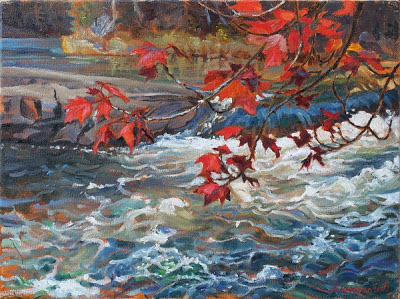Wetland Transitioning (oil on canvas 6 x 8 in)
29 September finds me painting a scene of rapid, man-made transition north of Kemptville, Ontario. This is a shallowly ditched sand flat, bulldozed from the previous habitat within the past calendar year, near a remnant patch of Red Maple/White Birch woods. Underfoot is flat sand, missing its layer of topsoil and forest. Beyond a shallow ditch looms a pile of tree roots from last year's clearing, and beyond that, the straight edge of natural vegetation and the tall trunks of old, flood-killed trees that marks a large wetland complex that is being transitioned to a major housing development. There's a whispy stand of the Native Reed, Phragmites australis (americanus subspecies), its lower stem nodes red & smooth, on a ridge of clayey sand at intersection of grid of bulldozed roadways.
The sand is whiskered with little early-disturbance annuals, and a pronounced grey-horizon podzol soil profile is exposed at the edge of the bulldozed area. A Great Blue Heron
flies in, lands, and wades my shallow pond. We've heard that there's a Heronry here, but we can't see any of the gaunt wetland tree trunks having nests at their tops.
We go north to a barely flowing ditch at the corner of the sand flat, draining a Alder wetland to the west. Coltsfoot, a pioneer in disturbed soil, is represented by only a few little plants, only 20-30 cm across with 4-6 cm leaves, separated by 2 m or so, not yet the big robust plants that will probably blanket the site in a few years. Some juvenile Leopard Frogs here are half the length of those we're seeing at home - 25, 30, & 45 mm snout-vent length. Why are these so small? - breeding sites must be stressfully deficient.
Then we walk a little way along a long straight bulldozer track northwards along the edge of the wetland, a grey road of crushed, twisted and splintered wood - one juvenile Wood Frog and one juvenile Leopard Frog hop out of our way. This strangely violent laneway runs between the wetland and the block of mature forest. A Spring Peeper starts up its autumn calling from somewhere in the woods beside me, where Fred has gone to measure the girth of a big old White Pine surrounded by Hemlocks. There are big Black Cherry trees with droopy leaves distinctive in the canopy. A 50 cm diameter fallen rotten Paper Birch nearby, and all sizes of leaves on the ground from Large-toothed Aspen and Sugar Maple. These woods are very diverse in trees, and likely as old or older than those across Old Highway 16 in the Forest Station and Crown Land.
I painted a wetland on County Rd 43 in Kemptville on 14 June, 2010. That tract has not been cleared yet, and although there is now a grocery store parking lot on one side, the scene is yet much the same as I painted it. But now I realize that what I thought was small and isolated at that time, is actually the southern edge of a large and important wetland complex stretching to the north which has, since my first painting, had a big chunk drained, filled, and built upon - and another big project seems to have been started south of that. I am not going to preach here about how wetlands benefit all of us - you can look that up if you don't already know.
Peepers continue to call, and as we leave, we pass a clump of the invasive European Reed, or 401 Grass, Phragmites australis (australis subspecies), an 8 metre patch of sparse shoots, the lower stem nodes green & rough, sprouting up along a shallow ditch of clayey sand, and we wonder if the native or the invader will come to dominate the site, or if some further human intervention will eliminate them both.
Dear patrons and supporters,
This painting is for sale for $325 to support our work for conservation. If you would like to purchase it, please contact me




Comments
Post a Comment
What do you think of this painting, and what do you know about the subject that I have painted?